
December 17, 2009 — The Utah Division of Wildlife Resources (DWR), the Utah School and Institutional Trust Lands Administration (SITLA) and the Utah Museum of Natural History at the University of Utah announced today that full management responsibilities for the historic Wilcox Ranch in Range Creek Canyon will be transferred to the museum beginning today, December 17, 2009.
Known for its remote and rugged landscape, Range Creek, located about 30 miles southeast of Price, Utah has become valued by researchers from across the country for its unique prehistoric Fremont archeological sites. The three organizations agree that this is the main reason the museum should manage the Wilcox Ranch.
In a three-way land transfer, SITLA will acquire the Wilcox Ranch from the DWR in exchange for 2,600 acres of University trust lands located in the Gordon Creek Wildlife Management Area west of Price. SITLA will then lease the Wilcox Ranch to the University for Use as a field research station.
According to Mike Canning, Habitat Section chief for the DWR, a conservation easement on the ranch property protects its wildlife habitat and cultural and historic resources in perpetuity. “We think this agreement among DWR, SITLA, and the museum will provide benefits for years to come,” said Canning. “Now that the museum is going to manage the area, a long-term comprehensive archeological research plan for the Range Creek property can be designed and implemented. At the same time, the area’s wildlife habitat and access to hunters, anglers, and wildlife watchers will be maintained. They will still have the same access to the area that they’ve enjoyed in recent years.”
DWR was appointed the responsible agency in 2004 when the Wilcox Ranch was transferred to the State of Utah from the Bureau of Land Management (BLM). The BLM acquired the land in 2000 from a private citizen. Since 2004, the DWR has worked cooperatively with the museum, the BLM, and other agencies to successfully manage the canyon’s multiple land uses. According to the museum, the current management strategies will remain in place for 2010. During this time, museum officials will work cooperatively to develop a comprehensive management plan that will address the next five to ten years.
For the past ten years, museum and U of U archeologists and staff have helped to direct the scientific research of Range Creek. Research activities have involved undergraduate summer field schools, independent research projects of Utah scientists from the College of Eastern Utah, Brigham Young University, and the U of U, focusing on archeology, botany, and geography. In addition, Range Creek has served as an outdoor laboratory for many science teacher workshops and as a hands-on field trip destination for area school children, as well as for other educational uses.
“We are pleased with the state’s decision and are confident that we can meet the needs of those interested and involved in Range Creek,” said Sarah George, executive director of the Utah Museum of Natural History. “Our approach will be collaborative with the goal of protecting this important resource for the residents of Utah.”
